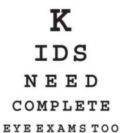August is Children’s Eye Health and Safety Month and a great time to have your children’s vision checked. The American Optometric Association suggests that infants have a comprehensive eye exam at 6 months of age with follow-ups at age 3 and again at 5 or 6. After age 6, a child’s eyes should be examined every two years unless they have eyeglasses or contact lenses which requires an annual examination.
The eye doctor should check for things such as nearsightedness, farsightedness, astigmatism, amblyopia (lazy eye), strabismus (crossed eyes), ptosis (drooping of eyelid) and color blindness.
In addition to regular eye exams, parents should watch for specific warning signs of vision problems. These include a family history of childhood vision problems, wandering or crossed eyes, disinterest in reading, squinting or turning the head while watching television, frequent rubbing or blinking, covering one eye or an eye that turns in or out.
In older children, parents should also watch for lack of comprehension or poor academic performance, child experiencing discomfort, fatigue or hyperactive behavior, holding reading materials and books close to face and losing track of place when reading.
General eye health also includes eye safety. Injuries are the leading cause of children’s vision loss. Each year, 42,000 sports-related eye injuries are reported and most of these are sustained by children.
Sports with the highest number of eye injuries are baseball, softball, ice hockey, racquet sports and basketball. A statistic that punctuates the need for protective eye wear is that every 13 minutes, a U.S. emergency room visit is the result of a sports-related eye injury.
Fortunately, 90 percent of sports-related eye injuries could be prevented with proper protective eye wear.
Also, purchase only age-appropriate toys for children and avoid those with sharp or protruding parts.
According to the Health Alliance Plan more than 12 million U.S. children have some kind of visual impairment, which is defined as a limitation of the eye that leads to a loss of visual acuity, limited peripheral vision, an inability to limit to look at light (photophobia), double vision (diplopia), visual distortion or perception difficulties.
Sources: http://yoursightmatters.com/august-childrens-eye-health-safety-month/, https://www.friendsforsight.org/resources/eye-health-awareness/item/13-child-eye-health-and-safety-month-august, https://www.preventblindness.org/childrens-eye-health-safety.


